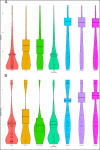Underrepresented Populations in Parkinson's Genetics Research: Current Landscape and Future Directions
- PMID: 35867623
- PMCID: PMC10360137
- DOI: 10.1002/mds.29126
Underrepresented Populations in Parkinson's Genetics Research: Current Landscape and Future Directions
Abstract
Background: Human genetics research lacks diversity; over 80% of genome-wide association studies have been conducted on individuals of European ancestry. In addition to limiting insights regarding disease mechanisms, disproportionate representation can create disparities preventing equitable implementation of personalized medicine.
Objective: This systematic review provides an overview of research involving Parkinson's disease (PD) genetics in underrepresented populations (URP) and sets a baseline to measure the future impact of current efforts in those populations.
Methods: We searched PubMed and EMBASE until October 2021 using search strings for "PD," "genetics," the main "URP," and and the countries in Latin America, Caribbean, Africa, Asia, and Oceania (excluding Australia and New Zealand). Inclusion criteria were original studies, written in English, reporting genetic results on PD from non-European populations. Two levels of independent reviewers identified and extracted information.
Results: We observed imbalances in PD genetic studies among URPs. Asian participants from Greater China were described in the majority of the articles published (57%), but other populations were less well studied; for example, Blacks were represented in just 4.0% of the publications. Also, although idiopathic PD was more studied than monogenic forms of the disease, most studies analyzed a limited number of genetic variants. We identified just nine studies using a genome-wide approach published up to 2021, including URPs.
Conclusion: This review provides insight into the significant lack of population diversity in PD research highlighting the immediate need for better representation. The Global Parkinson's Genetics Program (GP2) and similar initiatives aim to impact research in URPs, and the early metrics presented here can be used to measure progress in the field of PD genetics in the future. © 2022 International Parkinson and Movement Disorder Society.
Keywords: Parkinson's disease; diversity; genetics; systematic review; underrepresented populations.
© 2022 International Parkinson and Movement Disorder Society.
Conflict of interest statement
The authors have no conflicts of interest to declare.
Figures




References
Publication types
MeSH terms
LinkOut - more resources
Full Text Sources
Medical

